Civil Liberties: First Amendment Freedoms
Civil Liberties: First Amendment Freedoms. Chapter 5 Text Chapter 3 p. 103 Woll Reader. A Commitment to Freedom. The listing of the general rights of the people can be found in the first ten amendments in the Constitution, also known as the Bill of Rights .
Share Presentation
Embed Code
Link
Download Presentation
- different rights conflict
- present danger doctrine
- violent acts
- personal rights
- civil liberties
- new york times co

fleur + Follow
Download Presentation
Civil Liberties: First Amendment Freedoms
An Image/Link below is provided (as is) to download presentation Download Policy: Content on the Website is provided to you AS IS for your information and personal use and may not be sold / licensed / shared on other websites without getting consent from its author. Content is provided to you AS IS for your information and personal use only. Download presentation by click this link. While downloading, if for some reason you are not able to download a presentation, the publisher may have deleted the file from their server. During download, if you can't get a presentation, the file might be deleted by the publisher.
Presentation Transcript
- Civil Liberties: First Amendment Freedoms Chapter 5 Text Chapter 3 p. 103 Woll Reader
- A Commitment to Freedom • The listing of the general rights of the people can be found in the first ten amendments in the Constitution, also known as the Bill of Rights. • The 13th and 14th amendments have also added to the Constitution’s guarantees of personal freedom.
- Civil liberties definitions • In general, civil liberties are protections against government. • They are guarantees of the safety of persons, opinions, and property from arbitrary acts of government. • Personal Rights of Citizens
- Protection of Civil Liberties • InstitutionalCourts’ decisions on constitutionality of laws in violation of fundamental freedoms • Political Arousal of public support for principles of liberty by political and social leaders
- The Bill of Rights 1791 • Reason For or in Support See outline notes. LIST FOUR • Reasons Against Protection in the Ninth Amendment (1791) See outline notes • Article IV, section 2 “QUOTE FROM NOTES”
- The 9th Amendment • “The enumeration in the Constitution, of certain rights, shall not be construed to deny or disparage others retained by the people.” • The Ninth Amendment states that the American people possess rights that are not set out explicitly in the Constitution. • It has been used to protect rights as various as the rights of the accused to a woman’s right to abortion without undue interference by government.
- 1) The Ninth Amendment was included in the Bill of Rights • over the objections of Anti-Federalists • to protect rights which were not specifically listed • so that the states could not violate individual rights • in an effort to reserve specific rights for the states
- Limited Government • Throughout the Constitution, the extent of governmental authority is strictly limited. Article I, Section 10 No bills of attainder • No ex post facto laws • The rights that the Constitution guarantees to citizens are also limited. • People in the United States are free to do as they please as long as they do not infringe upon the rights of others. Rights are relative. • Sometimes, different rights conflict with one another, such as the freedom of the press and the right to a fair trial. • Not all rights are guaranteed to aliens, who are foreign-born residents or non-citizens. For instance, their right to travel is often restricted.
- The Bill of Rights The most famous of the Constitution’s guarantees apply only to the National Government, not the government of the States. The Supreme Court held that the Bill of Rights only restricts the National Government in Barron v. Baltimore, (1833). The Modifying Effect of the 14th Amendment The 14th Amendment’s Due Process Clause provides that no State can “deprive any person of life, liberty or property, without due process of law…”. WOLL p.106 However, to include rights under that heading, the Supreme Court had to define the rights on a case by case basis, called the process of incorporation. *** Gitlow v. New York (1925) DISCUSS See outline notes. Federalism and Individual Rights
- 2) The principle that the Supreme Court currently uses to extend the Bill of Rights to the Fourteenth Amendment is called • Incorporation • Bad tendency doctrine • A nonpreferential view • The accommodationist twist
- 3) The First Amendment clearly limits the powers of the • Supreme Court • Congress • President • State governments • Local governments • See Barron v. Baltimore
- 4) The significance of the Gitlow v. New York (1925) case was that it • mandated that state governments uphold the provisions of the federal Bill of Rights • interpreted the death penalty as a cruel and unusual punishment • upheld the constitutionality of the exclusionary rule • outlawed reverse discrimination
- 5) States are now prohibited from infringing upon the rights protected by the Federal Bill of Rights because • an executive order issued by President Washington • a provision in the Fourteenth amendment • legislative action by the first Congress • an introduction to the document which mandates it
- 6)When creating the Constitution, The Founding Fathers did not include a bill of rights because • they had too many other issues to consider • they were unsure of what to include • they believed such a bill was unnecessary because the states already had such protections • James Madison lobbied against such a bill Check Woll p. 103
- The First Amendment Freedoms • Freedom of Speech • Freedom of Press • Freedom of Assembly • Freedom of Petition • Freedom of Religion
- 7) The First Amendment protects all of the following freedoms EXCEPT: • Religion • Choice • Press • Assembly • Privacy
- Freedom of Speech: One • Freedom of Speech guarantees are meant to: • Protect each person’s right of free expression, whether spoken, written, or communicated in any other way. • Protect all persons’ right to a complete discussion of public affairs.
- Speech • Slander, the false and malicious use spoken words • ObscenityWords that incite others to commit crimes
- Seditious Speech Sedition is the crime of attempting to overthrow the government by force, or to disrupt its lawful activities by violent acts. Seditious speech is speech that urges such conduct.
- Congress has enacted three major laws to prevent sedition and seditious speech: • The Alien and Sedition Acts—made scandalous or false criticism of the government illegal. Expired before Thomas Jefferson took office in 1801. • Espionage Act 1917 Felony to cause insubordination in the army or interfere with enlistment. DISCUSS Schenck v. United States (1919) • And Abrams v. United States (1919) Schenck p.504-505 • The Sedition Act of 1917-1918—made it a crime to encourage disloyalty or spread anti-government ideas during a time of crisis. Upheld by the Supreme Court in instances of “clear and present danger.” • The Smith Act of 1940—forbade advocating violent overthrow of the government, and belonging knowingly to any group that does. The Supreme Court still upholds the constitutionality of the law, but over time has modified it so that it is difficult to enforce. Yates v. US (1957) and Brandenburg v. Ohio (1969)
- 8) Oliver Wendell Holmes first announced the celebrated clear and present danger doctrine in the case of • A. Barron v. Baltimore • B. Gitlow v. New York • C. Schenck v. United States • D. Lemon v. Kurtzman
- Symbolic speech is expression by conduct. Tinker vs. Des Moines Thought provoking or provocative IS protected. Supreme Court rulings show that the blanket of symbolic speech covers only so much. It does not cover destroying draft cards United States v. O’Brien, (1968) but it does encompass flag burning Texas v. Johnson, (1989), and United States v. Eichman, (1990). Symbolic Speech
- Chaplinsky v. New Hampshire (1942) • Fighting words that incite are NOT protected.
- 9) The Constitution protects speech that is • Provocative • Obscene • Seditious • Libelous • Abusive
- 10) A case that expanded the concept of symbolic speech to include the wearing of armbands in protest was • A. Tinker v. Des Moines • B. Engel v. Vitale • C. Mapp v. Ohio • D. Bakke v. Regents
- Freedom of the Press: Two • Obscenity laws are enforced under the postal power (Article I, Section 8, Clause 7 of the Constitution). Obscenity Test laid out in Miller v. California, (1973) • 1) The average person finds that the work appeals to “prurient interests” judging from contemporary standards. • 2) The work describes offensive sexual conduct that is specifically outlawed as obscene. • 3) The work lacks serious value of any variety.
- 11) Under the first amendment which Supreme Court decision set forth a 3 part test for determining obscenity? • Everson v. Board of Education • Lemon v. Kurtzman • Wallace v. Jaffree • Miller v. California
- 12) Constitutional protection is withheld from • Adult Books • Adult Magazines • Adult Movies • Sexually explicit photographs of minors
- Freedom of Press does not protect: • Libel, the false and malicious use of written words • CASES New York Times Co. v. Sullivan (1964) • Woll page120
- 13) Which of the following cases set guidelines for libel cases? • A. N. Y. Times v. United States • B. N. Y. Times v. Sullivan • C. Palko v. Connecticut • D. Near v. Minnesota
- Censorship In most cases, the government cannot curb ideas before they are expressed. It can punish ideas after they are expressed.
- Prior Restraint • The Supreme Court has held in several cases that the guarantee of a free press does not allow the government to exercise prior restraint on publication except in grave circumstances. In Near v. Minnesota (1931), the Court protected the rights of even “miscreant purveyors of scandal.” • In New York Times v. United States, (1971), the government sought a court order to keep newspapers from printing “the Pentagon Papers” which had been stolen and leaked to the press. The Supreme Court found that the government couldn’t show that the papers endangered national security enough to justify prior restraint of publication.
- 14) The term “prior restraint” would most likely be used in which of the following actions? • Arrest • Censorship • Amnesty • Sentencing for a crime
- 15) Which of the following cases dealt with “prior restraint”? • N. Y. Times v. United States • N. Y. Times v. Sullivan • Wisconsin v. Yoder • Snepp v. United States
- Snepp v. United States (1980) • CIA Permissible Prior Restraint • FREE PRESS v. FAIR TRIAL • Nebraska Press Association v. Stuart (1976)
- Freedom of Assembly: Three The Constitution guarantees “…the right of the people peaceably to assemble, and to petition the Government for a redress of grievances.” • The right to assemble, or gather with one another to express views. • The right to bring views to the attention of public officials.
- Time, Place and Manner Restrictions • Picketing, the patrolling of a business site by workers on strike, is a prevalent form of symbolic speech. • CASES Gregory v. Chicago, Hill v. Colorado, and Madsen
- Public Property
- Time-Place-Manner Regulations The government can make and enforce rules regarding the time, place, and manner of assemblies. • An example of such a rule is that public areas near schools and courthouses are restricted. • The government’s rules must becontent neutral.They can place restrictions of the basis of the time, place and manner of the assembly, but not on what the assembly is trying to say on PUBLIC PROPERTY.
- Private Property The rights of assembly and petition do not give people a right to trespass on private property. States can interpret their constitutions to require owners of private property, such as shopping centers, to allow people to petition on their property.
- Private Property • Lloyd Corporation v. Tanner (1972) • HOSTILE AUDIENCES Feiner v. New York (1952)
- 16) Time, place, and manner restrictions on freedom of expression are generally upheld by the courts if they • give local authorities adequate discretion to enforce them • apply only to obscene materials or libelous statements • do not make it overly difficult for a person to share their ideas with others • are not applied to traditional public forums such as street corners and public parks
- 17) Peaceful picketing • is protected absolutely by the First amendment • may only be regulated by Congress • may be regulated by the states under certain conditions • may be regulated by the states unconditionally
- The guarantees of freedom of assembly and petition include aright of association—the right to associate with others to promote causes. The freedom of association also means that a State cannot force an organization to accept members when that association would contradict what the organization believes in. Freedom of Association
- Freedom of Religion: Five Two guarantees of religious freedom: Establishment Clause • Guards against establishing a mandated religion. • In effect, freedom from religion Free Exercise Clause • Guards against the government interfering in the exercise of any religion. • In effect, freedom for religion.
- Church and government are constitutionally separated from one another. However, the government supports churches and religion in a variety of ways, including tax exemption. Separation of Church and StateA wall of separation?
- Everson v. Board of Education (1947) • The court did not rule on the meaning of the Establishment Clause until Everson which incorporated the clause to apply to the states.
- 18) In the Supreme Court case Everson v. Board of Education a “wall of separation” was created between church and state, which clause created the wall? • Establishment clause • Free Exercise clause • Due Process clause • Necessary and proper clause
- Court definition of the Establishment Clause • “Neither a state nor the federal government can set up a church, nor pass laws which aid one religion, all religions, or prefer one religion over another.” • “Neither can force a person to go to or remain away from a church against his will or force him to profess a belief or a disbelief in any religion.” • Finally, the government may not participate in religious affairs nor impose taxes for their support.
- McCullom v. Board of Education (1948) • Question: • Did the use of the public school system for religious classes violate the First Amendment's Establishment Clause? Load More .
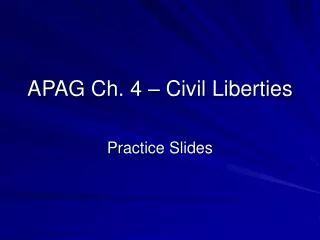
APAG Ch. 4 – Civil Liberties
APAG Ch. 4 – Civil Liberties. Practice Slides. The Supreme Court began applying the Bill of Rights to state governments (the process of incorporation ) in 1925 with the free speech case __________. Gitlow v. New York, 1925.
1.25k views • 80 slides
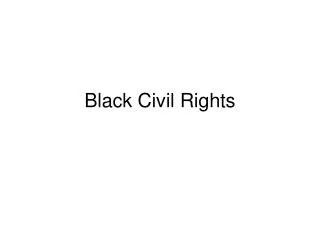
Black Civil Rights
Black Civil Rights. Overview. Early racial relations Leading up to Civil War Civil War and Reconstruction Jim Crow The Modern Civil Rights Movement. Early Race Relations. Slavery In the Constitution
996 views • 54 slides
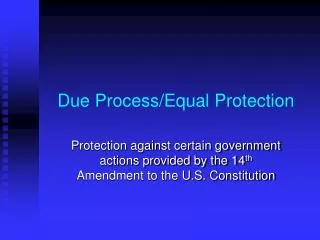
Due Process/Equal Protection
Due Process/Equal Protection. Protection against certain government actions provided by the 14 th Amendment to the U.S. Constitution. The 14 th Amendment. Post Civil War Legislation Makes the Bill of Rights applicable to the States It is the “work horse” amendment
1.6k views • 98 slides
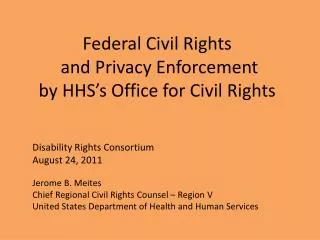
Federal Civil Rights and Privacy Enforcement by HHS’s Office for Civil Rights
Federal Civil Rights and Privacy Enforcement by HHS’s Office for Civil Rights . Disability Rights Consortium August 24, 2011 Jerome B. Meites Chief Regional Civil Rights Counsel – Region V United States Department of Health and Human Services. Topics to be Covered.
1.8k views • 127 slides
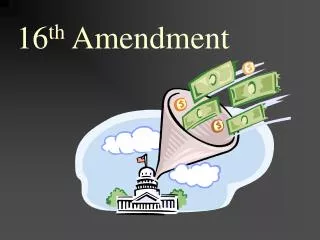
16 th Amendment
16 th Amendment. The 16th Amendment to the United States Constitution (1913) gave Congress the power to tax income . 17 th Amendment. Senate.
2.95k views • 137 slides
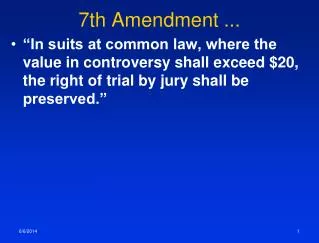
7th Amendment .
7th Amendment . “In suits at common law, where the value in controversy shall exceed $20, the right of trial by jury shall be preserved.”. Trial by jury.
1.7k views • 25 slides
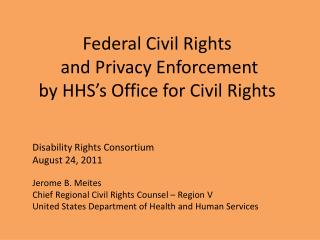
Federal Civil Rights and Privacy Enforcement by HHS’s Office for Civil Rights
Federal Civil Rights and Privacy Enforcement by HHS’s Office for Civil Rights . Disability Rights Consortium August 24, 2011 Jerome B. Meites Chief Regional Civil Rights Counsel – Region V United States Department of Health and Human Services. Topics to be Covered.
338 views • 0 slides
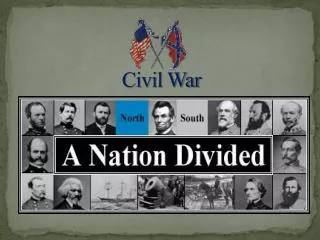
Civil War
Civil War. The American Civil War. From 1861, to 1865, for four long years Americans fought and killed one another. The Civil War. Who was involved? . #1 The Confederate States of America. The Civil War. Who was involved? . #2 The Union (Free States & Territories). The Civil War.
1.14k views • 70 slides

Welcome
Welcome. to. Civil Liberties/Rights Jeopardy!. Final Jeopardy. Round 1. Round 2. Who’s yer fav teacher? 1. Wuzup? 6. You da bomb 2. Pass da APGO 3. Who Loves Ya? 4. Yo Mama 5. Round 2. Final Jeopardy. $100. $100. $100. $100. $100. $100. $200. $200. $200. $200. $200.
898 views • 69 slides

Section 1: The First Amendment: Your Freedom of Expression
Section 1: The First Amendment: Your Freedom of Expression Section 2: The Fourth Amendment: Your Right to Be Secure Section 3: Due Process and the Fourteenth Amendment Section 4: Federalism and the Supreme Court. Chapter 13: Supreme Court Cases. Section 1 at a Glance.
1.32k views • 111 slides
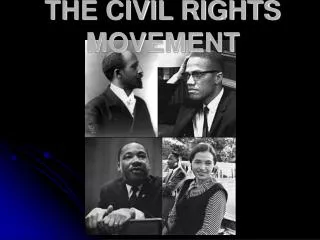
THE CIVIL RIGHTS MOVEMENT
THE CIVIL RIGHTS MOVEMENT. THE CIVIL RIGHTS MOVEMENT. I. VOTING RIGHTS. 15 th Amendment (1869). extended the right to vote to all males regardless of race. JIM CROW LAWS. laws that required segregation by race. Segregated Bus Station in Dallas, Texas. POLL TAX.
1.09k views • 89 slides
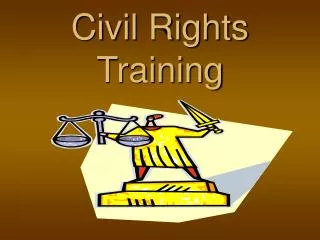
Civil Rights Training
Civil Rights Training. Welcome Bienvenidos, Nyob Zoo, Huan Ying, Bienvenue, Boa Vinda, ‘So Dhowaada’. AGENDA. Welcome What is discrimination/Civil Rights Review of Civil Rights Laws/Guidance Break BCR Complaint Process and Procedures Questions/Evaluations Adjourn. Objectives.
994 views • 65 slides
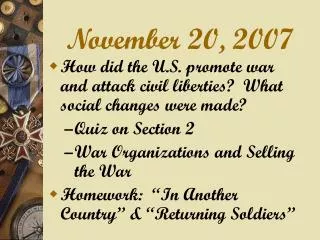
November 20, 2007
November 20, 2007. How did the U.S. promote war and attack civil liberties? What social changes were made? Quiz on Section 2 War Organizations and Selling the War Homework: “In Another Country” & “Returning Soldiers”. Congress Gives Power to Wilson.
1.01k views • 76 slides
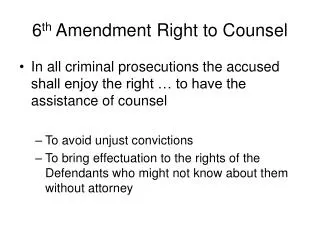
6 th Amendment Right to Counsel
6 th Amendment Right to Counsel. In all criminal prosecutions the accused shall enjoy the right … to have the assistance of counsel To avoid unjust convictions To bring effectuation to the rights of the Defendants who might not know about them without attorney. Guideon v. Wainwright.
1.21k views • 4 slides

CIVIL RIGHTS & LIBERTIES
CIVIL RIGHTS & LIBERTIES. By Loren Miller. CIVIL RIGHTS. Bill of Rights Unanimously defeated at the convention Unnecessary as state constitutions protected individual rights So why was it proposed in 1789? What is its purpose? To limit the power of government
1.94k views • 166 slides
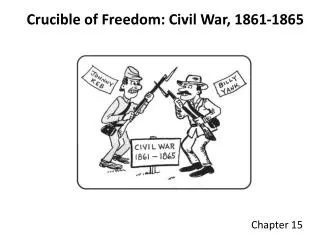
Crucible of Freedom: Civil War, 1861-1865
Crucible of Freedom: Civil War, 1861-1865. Chapter 15. Causes of the Civil War. The American Civil War (1861-1865). Introduction Lincoln’s Dilemma Opposing Sides and Strategies Early War (1861-2) East and West Emancipation Civil War Soldiers Draft and Riots Life for Soldiers
1.42k views • 79 slides
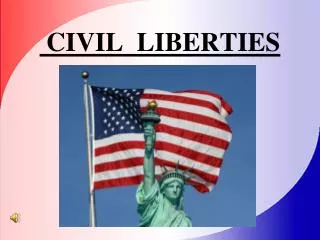
CIVIL LIBERTIES
CIVIL LIBERTIES. BILL OF RIGHTS #1-#10 FEDERAL…. STATES(#14) INCORPORATION. STUDENT BILL OF RIGHTS. BILL OF RESPONSIBILITIES. 4.KEY CONCEPTS. 1.GUARANTEED. 2.RELATIVE…. NOT ABSOLUTE. 3. APPLY TO ALL. 4.RIGHTS IN CONFLICT… EXAMPLES…. FREE PRESS (1) VS. FAIR TRIAL (6).
1.77k views • 161 slides

CIVIL RIGHTS & LIBERTIES
CIVIL RIGHTS & LIBERTIES. By Loren Miller. CIVIL RIGHTS. Bill of Rights Unanimously defeated at the convention Unnecessary as state constitutions protected individual rights So why was it proposed in 1789? What is its purpose? To limit the power of government
1.8k views • 155 slides

CIVIL LIBERTIES
CIVIL LIBERTIES. BILL OF RIGHTS #1-#10 FEDERAL…. STATES(#14) INCORPORATION. 4.KEY CONCEPTS. 1.GUARANTEED. 2.RELATIVE…. NOT ABSOLUTE. 3. APPLY TO ALL. 4.RIGHTS IN CONFLICT… EXAMPLES…. FREE PRESS (1) VS. FAIR TRIAL (6). FREE SPEECH (1) VS. PUBLIC ORDER.
1.76k views • 154 slides

The Civil Rights Movement
The Civil Rights Movement. Essential Questions. What impact did the Dred Scott case and the Emancipation Proclamation have on the early struggle for civil rights? Why did the Supreme Court interpret early civil rights laws and the 14th Amendment narrowly in the late 19th century?
1.28k views • 76 slides

The Civil Rights Movement
The Civil Rights Movement. Plessy v Furgeson. In 1896,the Supreme Court decided that separate but equal based on race was not in violation of the 14th Amendment. Separate but equal becomes the “Status Quo” for the next half-century.
1.26k views • 110 slides
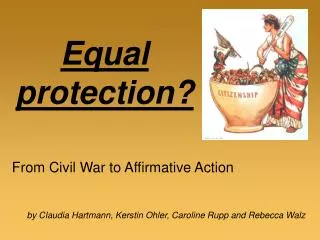
Equal protection?
Equal protection?. From Civil War to Affirmative Action by Claudia Hartmann, Kerstin Ohler, Caroline Rupp and Rebecca Walz. Equal Protection. Background:. part of the 14 th Amendment to the United States Constitution. enacted in 1868 , shortly after the American Civil War.
956 views • 80 slides
























